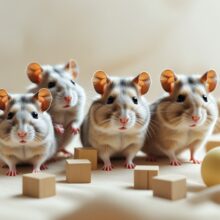Environmental Enrichment for Gerbils

Environmental Enrichment for Gerbils: Enhancing Their Quality of Life
Gerbils are active, curious, and intelligent animals that thrive in environments that provide mental and physical stimulation. Environmental enrichment is essential for ensuring their well-being, preventing boredom, and promoting natural behaviors. This comprehensive guide will explore the various aspects of environmental enrichment for gerbils, including the importance of enrichment, types of enrichment, and practical tips for creating a stimulating habitat.
Importance of Environmental Enrichment
Environmental enrichment is crucial for gerbils for several reasons:
- Mental Stimulation: Enrichment activities keep gerbils’ minds active and engaged, preventing boredom and promoting cognitive development.
- Physical Exercise: Providing opportunities for physical activity helps maintain a healthy weight and overall fitness.
- Natural Behaviors: Enrichment items allow gerbils to express natural behaviors such as digging, gnawing, and foraging.
- Stress Reduction: A stimulating environment reduces stress and anxiety, leading to happier and healthier gerbils.
- Preventing Behavioral Issues: Enrichment helps prevent destructive behaviors that can result from boredom and lack of stimulation.
Types of Environmental Enrichment
There are various types of enrichment that cater to different aspects of gerbil behavior and needs. Here are some key types of enrichment for gerbils:
- Social Enrichment
Gerbils are social animals that thrive on interaction with their fellow gerbils. Keeping gerbils in pairs or small groups provides social enrichment and prevents loneliness.
- Companionship: Ensure your gerbils have companions of the same species. Gerbils kept alone can become stressed and develop behavioral issues.
- Social Interaction: Encourage social behaviors such as mutual grooming, playing, and huddling by providing a spacious and enriching environment.
- Physical Enrichment
Physical enrichment involves providing opportunities for exercise and physical activity.
- Exercise Wheels: An exercise wheel is essential for physical activity. Choose a wheel with a solid running surface to prevent injuries. The wheel should be large enough for your gerbil to run comfortably without arching its back (at least 8 inches in diameter).
- Climbing Structures: Add branches, ladders, and platforms to encourage climbing and exploration. Ensure that any climbing structures are stable and securely attached to prevent accidents.
- Foraging Enrichment
Foraging enrichment encourages natural foraging behavior and provides mental stimulation.
- Scatter Feeding: Instead of placing food in a dish, scatter it around the cage to encourage foraging behavior. This mimics the natural process of searching for food.
- Puzzle Feeders: Use food-dispensing toys and puzzles to challenge your gerbils and stimulate their minds. These toys can provide hours of entertainment and enrichment.
- Tactile Enrichment
Tactile enrichment involves providing different textures and materials for your gerbils to explore.
- Bedding Materials: Use a variety of bedding materials such as aspen shavings, paper-based bedding, and hay. Providing a mix of textures encourages digging and burrowing.
- Digging Box: Create a digging box using a shallow container filled with safe, dust-free sand or soil. Gerbils love to dig and burrow, and a digging box provides an additional outlet for this natural behavior.
- Gnawing Enrichment
Gnawing enrichment is essential for maintaining healthy teeth and preventing overgrowth.
- Chew Toys: Offer a variety of chew toys made from safe materials like untreated wood, cardboard, and coconut shells. Rotate the toys regularly to keep your gerbils interested and engaged.
- Natural Branches: Provide natural branches such as applewood or willow for your gerbils to gnaw on. Ensure the branches are untreated and free of pesticides.
- Sensory Enrichment
Sensory enrichment engages your gerbils’ senses and provides novel experiences.
- New Scents: Introduce new scents to your gerbils’ environment by placing safe, natural items such as herbs or flowers in their cage. This stimulates their sense of smell and adds variety.
- Sound Stimulation: Play soft, calming music or natural sounds to provide auditory enrichment. Avoid loud or sudden noises that can cause stress.
Practical Tips for Creating a Stimulating Habitat
Creating a stimulating habitat for your gerbils involves incorporating various types of enrichment and ensuring a safe and comfortable environment. Here are some practical tips:
- Spacious Cage
Provide a spacious cage with plenty of room for exploration and enrichment. A larger cage allows for more toys and activities, reducing boredom and encouraging natural behaviors.
- Varied Enrichment Items
Include a variety of enrichment items in the cage to keep your gerbils entertained. Rotate toys and activities regularly to maintain their interest and prevent boredom.
- Natural Materials
Use natural materials like wood, hay, and cardboard to create a more enriching and comfortable environment. These materials are safe for gnawing and provide a more natural habitat for your gerbils.
- Interactive Play
Engage in interactive play sessions with your gerbils outside the cage. Use your hands, toys, and treats to interact with your gerbils and provide additional mental and physical stimulation.
- Clean and Safe Environment
Maintain a clean and safe environment by performing regular cage cleaning and inspecting toys for wear and tear. Remove any damaged or hazardous items to prevent injuries.
DIY Enrichment Ideas
Creating DIY enrichment items is a fun and cost-effective way to provide stimulation for your gerbils. Here are some simple DIY ideas:
- Cardboard Mazes
Create a maze using cardboard boxes and tubes. Cut out entrances and exits to form a complex maze for your gerbils to explore. This provides mental stimulation and encourages natural foraging behavior.
- Hanging Toys
Make hanging toys using pieces of untreated wood, string, and cardboard. Hang these toys from the top of the cage to encourage climbing and gnawing.
- Treat Rolls
Fill cardboard tubes with hay, treats, and shredded paper. Seal the ends with more paper or hay, creating a foraging toy that challenges your gerbils to work for their treats.
- Digging Box
Create a digging box using a shallow container filled with dust-free sand or soil. Gerbils love to dig and burrow, and a digging box provides an additional outlet for this natural behavior.
Monitoring and Adjusting Enrichment
Regularly monitor your gerbils’ behavior and interactions with enrichment items to ensure they are engaged and satisfied. Make adjustments as needed to keep their environment stimulating and enjoyable.
- Observe Behavior: Pay attention to how your gerbils interact with their enrichment items. If they seem uninterested or bored, try introducing new toys or activities.
- Rotate Toys: Regularly rotate toys and enrichment items to maintain their interest. This keeps their environment fresh and engaging.
- Customize Enrichment: Tailor enrichment activities to your gerbils’ preferences and needs. Some gerbils may prefer digging and burrowing, while others may enjoy climbing and gnawing.
Conclusion
Environmental enrichment is essential for the well-being of gerbils, providing mental and physical stimulation, promoting natural behaviors, and reducing stress. By incorporating a variety of enrichment activities and items, you can create a stimulating habitat that enhances your gerbils’ quality of life. Whether you choose commercial toys or create your own DIY enrichment items, the key is to offer a diverse and ever-changing array of activities that keep your gerbils entertained and enriched. With the right care and attention, your gerbils can thrive and bring joy and companionship to your life.



